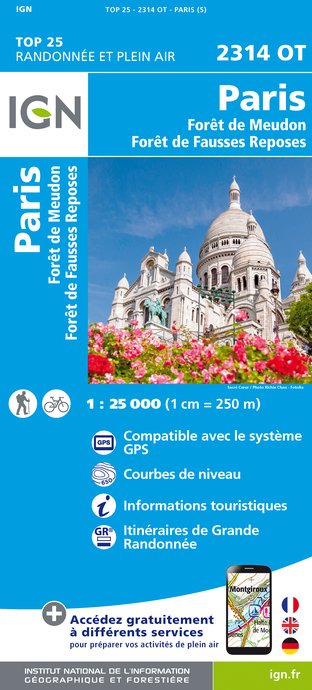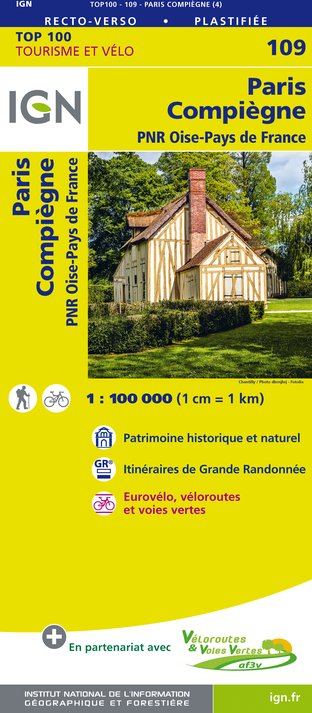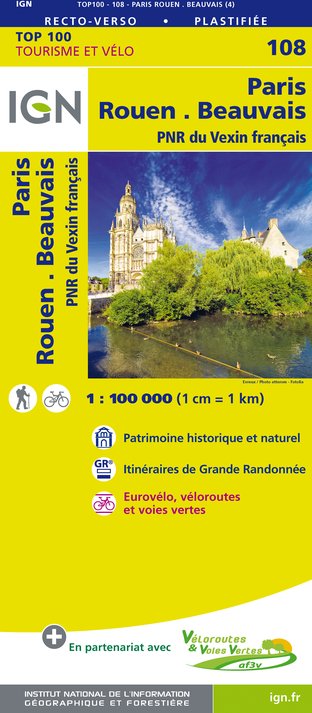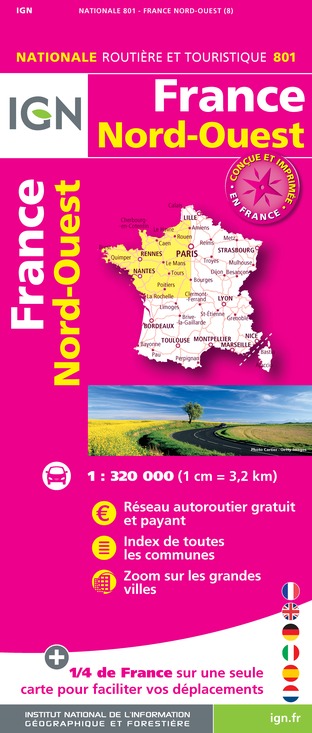Waarschuwing
Waarschuwingen
Type oefening
Wandel
Fiets
Presentatie
Kaart
Punten van interesse
Cirkwi's opdracht
Beoordelingen en recensies
Zie rondom
Het Onbekende van de Seine

Credit : unbekannt
De Cirkwi brief
Het onthullen van Parijs: Het pad van de Onbekende Dame van de Seine
Voorgesteld door Balades Fluviales Fabienne Lemoine Fondateur, dompelt deze route je onder in een Parijs verhaal gehuld in mysterie en artistieke expressie. De Onbekende Dame van de Seine, wiens levenloze schoonheid talloze kunstenaars en schrijvers heeft geïnspireerd, fungeert als een spookachtige gids doorheen de voorbije dagen van Parijs. Deze reis neemt ons mee voorbij de gebruikelijke bezienswaardigheden om de diepte van de ziel van de stad te verkennen. Terwijl we in de voetsporen van de Parijse geschiedenis wandelen, worden we eraan herinnerd dat schoonheid kan voortkomen uit tragedie en een tijdloze aantrekkingskracht kan uitoefenen op de Lichtstad. Dit unieke pad belooft een verkenning van de minder bekende verhalen van Parijs, gefluisterd door de rivier de Seine.
Technisch Overzicht van de Route
Deze wandelroute strekt zich uit over ongeveer 3,87 km en leidt ons door hoogteverschillen variërend van 27 meter tot een bescheiden piek van 37 meter. De stijging en daling fluctueren lichtjes, met een totale hoogteverandering van 5-7 meter. Dit profiel suggereert een ontspannen wandeling die geschikt is voor deelnemers van alle fitnessniveaus. Gezien de relatief korte afstand en minimale hoogteverschillen, is deze route toegankelijk, waardoor er voldoende tijd is voor contemplatie en ontdekking zonder de noodzaak van gespecialiseerde uitrusting of uitgebreide fysieke voorbereiding.
Seizoensgebonden Tips voor Reizigers
Bij het plannen van uw bezoek, houd rekening met de wisselende seizoenen in Parijs. Lente en herfst bieden milde temperaturen en minder drukte, waardoor ze ideaal zijn voor ontspannen wandelingen door de historische paden van de stad. In de zomer is de schoonheid van Parijs onmiskenbaar, maar bereid u voor op grotere drukte en warmer weer - voldoende hydrateren en zonbescherming dragen is een must. De winter heeft zijn eigen charme met minder toeristen en de mogelijkheid om Parijs bedekt te zien met sneeuw. Zorg ervoor dat u lagen draagt en comfortabel schoeisel, aangezien de wandeling verschillende oppervlakken omvat. Ongeacht het seizoen, controleer altijd de weersvoorspelling voordat u vertrekt om optimaal van Parijs te kunnen genieten.
Parijs: Een Stad Doordrenkt van Geschiedenis
De reis door Parijs is niet zomaar een wandeling; het is een tijdreis. De stad, met zijn wortels diepgeworteld in de Franse cultuur en geschiedenis, biedt een uniek perspectief op het verleden. Parijs, een stad die revoluties, triomfen en tragedies heeft meegemaakt, nodigt ontdekkingsreizigers uit om zich te verdiepen in zijn rijke tapijt van geschiedenis. De historische betekenis van de regio reikt verder dan Frankrijk en heeft invloed gehad op kunst, politiek en cultuur op mondiaal niveau. Deze route verheft het verhaal van een onbekende vrouw tot een symbool van het voortdurende mysterie en de schoonheid van Parijs, waarbij de stad haar vermogen toont om de verbeelding te betoveren door de eeuwen heen.
Klimaatinzichten voor Reizigers naar Parijs
Het klimaat in Parijs wordt gekenmerkt door zijn gematigde, enigszins onvoorspelbare aard. De winters zijn koel, met af en toe vorst en zeldzame sneeuwval, terwijl de zomers warm kunnen zijn maar niet buitensporig, met een comfortabele ambiance om te verkennen. De beste bezoektijden zijn meestal laat in de lente (mei tot juni) of vroeg in de herfst (september tot oktober), wanneer het weer aangenaam mild is en de tuinen van de stad volop in bloei zijn of majestueus transformeren. Deze seizoenen beloven een prachtige achtergrond voor het volgen van de stappen van de raadselachtige Onbekende Dame van de Seine, met minder regenonderbrekingen en een gematigd klimaat dat de algehele ervaring versterkt.
Voorgesteld door Balades Fluviales Fabienne Lemoine Fondateur, dompelt deze route je onder in een Parijs verhaal gehuld in mysterie en artistieke expressie. De Onbekende Dame van de Seine, wiens levenloze schoonheid talloze kunstenaars en schrijvers heeft geïnspireerd, fungeert als een spookachtige gids doorheen de voorbije dagen van Parijs. Deze reis neemt ons mee voorbij de gebruikelijke bezienswaardigheden om de diepte van de ziel van de stad te verkennen. Terwijl we in de voetsporen van de Parijse geschiedenis wandelen, worden we eraan herinnerd dat schoonheid kan voortkomen uit tragedie en een tijdloze aantrekkingskracht kan uitoefenen op de Lichtstad. Dit unieke pad belooft een verkenning van de minder bekende verhalen van Parijs, gefluisterd door de rivier de Seine.
Technisch Overzicht van de Route
Deze wandelroute strekt zich uit over ongeveer 3,87 km en leidt ons door hoogteverschillen variërend van 27 meter tot een bescheiden piek van 37 meter. De stijging en daling fluctueren lichtjes, met een totale hoogteverandering van 5-7 meter. Dit profiel suggereert een ontspannen wandeling die geschikt is voor deelnemers van alle fitnessniveaus. Gezien de relatief korte afstand en minimale hoogteverschillen, is deze route toegankelijk, waardoor er voldoende tijd is voor contemplatie en ontdekking zonder de noodzaak van gespecialiseerde uitrusting of uitgebreide fysieke voorbereiding.
Seizoensgebonden Tips voor Reizigers
Bij het plannen van uw bezoek, houd rekening met de wisselende seizoenen in Parijs. Lente en herfst bieden milde temperaturen en minder drukte, waardoor ze ideaal zijn voor ontspannen wandelingen door de historische paden van de stad. In de zomer is de schoonheid van Parijs onmiskenbaar, maar bereid u voor op grotere drukte en warmer weer - voldoende hydrateren en zonbescherming dragen is een must. De winter heeft zijn eigen charme met minder toeristen en de mogelijkheid om Parijs bedekt te zien met sneeuw. Zorg ervoor dat u lagen draagt en comfortabel schoeisel, aangezien de wandeling verschillende oppervlakken omvat. Ongeacht het seizoen, controleer altijd de weersvoorspelling voordat u vertrekt om optimaal van Parijs te kunnen genieten.
Parijs: Een Stad Doordrenkt van Geschiedenis
De reis door Parijs is niet zomaar een wandeling; het is een tijdreis. De stad, met zijn wortels diepgeworteld in de Franse cultuur en geschiedenis, biedt een uniek perspectief op het verleden. Parijs, een stad die revoluties, triomfen en tragedies heeft meegemaakt, nodigt ontdekkingsreizigers uit om zich te verdiepen in zijn rijke tapijt van geschiedenis. De historische betekenis van de regio reikt verder dan Frankrijk en heeft invloed gehad op kunst, politiek en cultuur op mondiaal niveau. Deze route verheft het verhaal van een onbekende vrouw tot een symbool van het voortdurende mysterie en de schoonheid van Parijs, waarbij de stad haar vermogen toont om de verbeelding te betoveren door de eeuwen heen.
Klimaatinzichten voor Reizigers naar Parijs
Het klimaat in Parijs wordt gekenmerkt door zijn gematigde, enigszins onvoorspelbare aard. De winters zijn koel, met af en toe vorst en zeldzame sneeuwval, terwijl de zomers warm kunnen zijn maar niet buitensporig, met een comfortabele ambiance om te verkennen. De beste bezoektijden zijn meestal laat in de lente (mei tot juni) of vroeg in de herfst (september tot oktober), wanneer het weer aangenaam mild is en de tuinen van de stad volop in bloei zijn of majestueus transformeren. Deze seizoenen beloven een prachtige achtergrond voor het volgen van de stappen van de raadselachtige Onbekende Dame van de Seine, met minder regenonderbrekingen en een gematigd klimaat dat de algehele ervaring versterkt.
Automatisch gegenereerd.
IGN kaarten

2314OT - PARIS FORÊT DE MEUDON FORÊT DE FAUSSES REPOSES
Uitgever : IGN
Verzameling : TOP 25 ET SÉRIE BLEUE
Ladder : 1:25 000
13.90€

119 PARIS SENS PNR DU GÂTINAIS FRANÇAIS
Uitgever : IGN
Verzameling : TOP 100
Ladder : 1:100 000
8.40€

190 PARIS CHANTILLY FONTAINEBLEAU
Uitgever : IGN
Verzameling : TOP 100
Ladder : 1:100 000
8.40€

118 PARIS CHARTRES PNR DE LA HAUTE VALLÉE DE CHEVREUSE
Uitgever : IGN
Verzameling : TOP 100
Ladder : 1:100 000
8.40€

109 PARIS COMPIÈGNE PNR OISE-PAYS DE FRANCE
Uitgever : IGN
Verzameling : TOP 100
Ladder : 1:100 000
8.40€

108 PARIS ROUEN BEAUVAIS PNR DU VEXIN FRANÇAIS
Uitgever : IGN
Verzameling : TOP 100
Ladder : 1:100 000
8.40€

D75-95 ÎLE-DE-FRANCE OUEST
Uitgever : IGN
Verzameling : CARTES DÉPARTEMENTALES IGN
Ladder : 1:150 000
5.90€

D77 SEINE-ET-MARNE
Uitgever : IGN
Verzameling : CARTES DÉPARTEMENTALES IGN
Ladder : 1:150 000
5.90€

NR08 CENTRE-VAL DE LOIRE
Uitgever : IGN
Verzameling : CARTES RÉGIONALES IGN
Ladder : 1:250 000
6.80€

NR03 ÍLE DE FRANCE
Uitgever : IGN
Verzameling : CARTES RÉGIONALES IGN
Ladder : 1:250 000
6.80€

NR01 HAUTS-DE-FRANCE
Uitgever : IGN
Verzameling : CARTES RÉGIONALES IGN
Ladder : 1:250 000
6.80€

801 FRANCE NORD OUEST
Uitgever : IGN
Verzameling : CARTES NATIONALES IGN
Ladder : 1:320 000
6.10€

EUROPE
Uitgever : IGN
Verzameling : DÉCOUVERTE DES PAYS DU MONDE IGN
Ladder : 1:2 500 000
7.00€
Technische informatie
Wandel
Moeilijkheid
Niet gespecificeerd
Afstand
3.9 km
Type oefening
Wandel
Fiets
Meer informatie tonen
Hoogteprofiel
Startpunt
75002
Paris
Lat : 48.86835Lng : 2.35194
Punten van interesse
Gegevensauteur
Beoordelingen en recensies
Om te zien rondom




